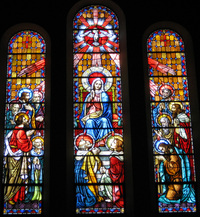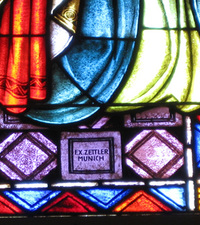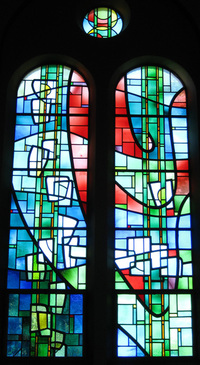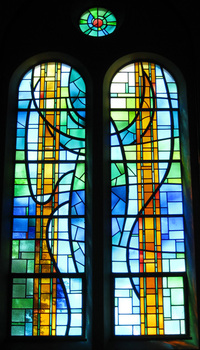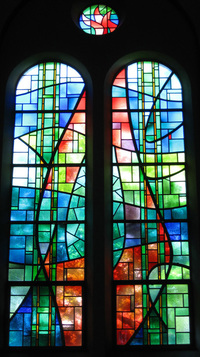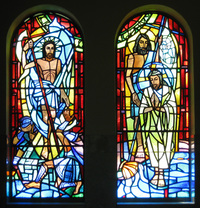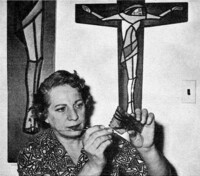MSGC : Featured Windows : Current Window
Featured Windows, November-December 2009
St. Veronica Catholic Church and Convent
Buildings:
St. Veronica Catholic Church - Eastpointe, Michigan
St. Veronica Catholic Church convent - Eastpointe, Michigan
St. Veronica Catholic Church, Eastpointe, MI. Built 1956-58. McGrath and Dohman, Architects.
St. Veronica Parish was established in 1926 in a community that became East Detroit and later renamed Eastpointe. Its first permanent home, completed in 1929, included a church, chapel, school, rectory and convent. By mid-century the parish was one of the largest in the Archdiocese of Detroit and a new church, designed by Detroit architects McGrath and Dohman to seat 1150, was constructed in 1956-1958. Continued growth of the parish and Vatican II liturgical changes required additions and alterations to the church and other buildings of the parish during the 1960s and 1970s. The windows of St. Veronica Church were created in the late 1950s by F. X. Zettler of Munich, Germany, and in the 1960s by Mary F. Giovann of Eastpointe. Giovann, a St. Veronica parishioner, also created windows and a mosaic for the convent chapel.
Zettler’s windows for St. Veronica Church include four chancel windows filled with Christian symbols and three large pictorial windows depicting scenes of the Nativity, Ascension and Pentecost. After training at Ludwig College and Art School, Franz Zayer Zettler (1841-1916) joined Franz Mayer & Co. in 1863 as art director. In 1870 he founded his own studio, the Institute of Ecclesiastical Stained Glass Windows. In 1873, under the patronage of King Ludwig II, the studio was renamed the Royal Bavarian Art Institute for Pictorial Painting on Glass. Zettler sold his windows to American clients through the Swiss firm Benziger Brothers during the 1800s and through the Daprato Statuary Company of Chicago and New York City after 1906. His two sons, Franz and Oskar, managed the studio after their father’s death, with Oskar in charge of overseas operations. Oskar’s son, Oscar Zettler, Jr., later took over the studio and in 1939 the Zettler company joined with the Mayer firm. Both Zettler and Mayer studios were known for their “Munich Style” windows that feature richly detailed settings and exquisitely painted figures.
Left: Pentecost Window. F.X. Zettler, Munich, Germany. Ca. 1956.
Right: Detail of Pentecost Window with signature of F.X. Zettler, Munich.
One of three large windows by the Zettler firm for St. Veronica Catholic Church, this window represents a scene described in the Book of Acts, Chapter 2:1-4, when the Holy Spirit descended like “tongues of flame” upon the Apostles and other followers of Jesus, enabling them to speak in many languages. Mary, the mother of Jesus, is often included in Pentecost scenes.
Mary Giovann’s windows for St. Veronica Church provide an interesting stylistic contrast to those by Zettler. For the nave, Giovann produced a series of abstract designs that symbolize the spiritual history of mankind, from creation to salvation through resurrection. The non-figurative windows utilize color, line and shape to represent events in that history. Four more windows in the baptistry reflect the meaning of the sacrament of baptism. In addition, Giovann designed a mosaic and five windows for the convent chapel, depicting Biblical women and women saints, including Ruth, Judith, St. Elizabeth, St. Catherine of Sienna, and St. Theresa of Avila.
After her early education at St. Mary’s Academy in Monroe, MI, Giovann lived in the Detroit area, where she studied art and drama at Cass Technical High School, followed by art training at Wayne State University, and the Society of Arts and Crafts (now the College for Creative Studies) under well-known Detroit painter Sarkis Sarkesian. She also spent one year as an apprentice at the Bleecher Manikin Studio, gaining experience in clay modeling and plaster casting. During her multi-faceted career, Giovann was director, actress and set designer for plays performed at the Detroit Institute of Arts, did social work at the League of Catholic Women’s Weinman Settlement where she organized a puppet theatre, music enrichment program, and art and craft classes, taught and lectured on art and puppetry, supervised the J. L. Hudson Company art supply department, was the preparator-technician for Detroit’s Children’s Museum, painted portraits, and designed numerous windows for the Detroit Stained Glass Works. Her stained glass work, marked by stylized designs and strong color, includes windows at Michigan churches, convents, seminaries, and the Children’s Museum, many of which have been registered in the Michigan Stained Glass Census.
Left: Exodus Windows. Mary Giovann, Eastpointe, MI. 1968.
Right: Mary and the Church Windows. Mary Giovann, Eastpointe, MI. 1968.
The abstract designs of the nave windows employ shape, line and color to symbolize their themes. In these windows, rectangular shapes represent both the Exodus of the Israelites from Egypt and mankind’s journey through history; red symbolizes the power of God intervening in human affairs; and green represents man’s hope for mercy and redemption. Mary, the mother of Jesus, is represented here by predominantly blue glass enclosed by vertical lines sweeping upward toward the red of the Holy Spirit in the circular window above. Following Vatican II guidelines of the 1960s, the windows honor Mary as the pre-eminent member of the Church and exemplary model of Church membership.
Left: Holy Spirit Windows. Mary Giovann, Eastpointe, MI. 1968.
Right: Baptism and Resurrection Windows. Mary Giovann, Eastpointe, MI. 1967.
This depiction of the Holy Spirit as a large red flame repeats the symbolism set forth in the Pentecost Window created by Zettler. These windows in the church baptistry represent the baptism of Jesus by St. John the Baptist and the resurrection of Jesus, symbolizing new life through the sacrament of baptism.
Left: Ruth Window for the convent chapel. Mary Giovann, Eastpointe, MI. 1965.
Right: Judith Window for the convent chapel. Mary Giovann, Eastpointe, MI. 1965.
The Old Testament Book of Ruth relates the story of the widow Ruth, who gleaned leftover barley in the fields to feed her mother-in-law Naomi. The landowner Boaz admired her devotion to Naomi and married her. Their descendents included David, the Psalmist and King of Israel. Ruth is shown holding a few grains of barley. Below her figure, a heart, symbolizing her devotion and piety, is inside the Star of David. In the Old Testament Book of Judith, the Jewish widow Judith gained entrance to the tent of the Assyrian enemy leader Holofernes, whom she slew with his sword as he lay in a drunken stupor, thereby saving her people. She is depicted with the sword of Holofernes. The lyre below her figure represents the “Canticle of Thanksgiving” attributed to her.
Left: St. Elizabeth Window for the convent chapel. Mary Giovann, Eastpointe, MI. 1965.
Right: Mary Giovann, ca. 1966. Photo courtesy of St. Veronica Catholic Church.
St. Elizabeth, the mother of John the Baptist, is identified in the New Testament Book of Luke as an elderly kinswoman of Mary, the mother of Jesus whom John baptized. She holds a winged wheel, the symbol of divine power that enabled her to bear a child.
St. Veronica Catholic Church and Convent were registered in the Michigan Stained Glass Census by Darlene Sue Young, with photography by Robert Brown, both of Eastpointe, MI.
Bibliography:
Show BibliographyFarnsworth, Jean M. "Biographical Sketches of Stained-Glass Studios and Selected Artists," in Farnsworth, Jean M., Carmen R. Croce, and Joseph F. Chorpenning. Stained Glass in Catholic Philadelphia. Philadelphia: Saint Joseph's University Press, 2002.
Giovann, Mary. “The Meaning of Symbols for Windows of Baptistry at St. Veronica,” 1968.
“Mosaic for Convent Chapel: Its Inspiration and Meaning,” 1967.
Taped interviews with St. Veronica’s Worship Commission to explain the symbolism of her windows for the church, ca. 1968.
“Description of Saints for Stained Glass Windows of Convent Chapel, St. Veronica,” 1965.
Giovann Studios. Contract between St. Veronica’s Parish and Giovann Studios for a total of 30 windows, signed by Rev. John A. Donovan, Pastor, and Mary F. Giovann, Owner, dated December 27, 1966.
The Holy Bible, King James Version.Hribar, Robert J. “History of St. Veronica Parish,” Eastpointe, MI: St. Veronica Parish Directory, 2000.
Ferguson, George. Signs and Symbols in Christian Art. New York: Oxford University Press, 1961.
Klimek, Mary K. “A Reflection on Our Past: History of St. Veronica Church: 60 Years Together,” 1986.
Young, Darlene Sue and Denise Szykula Giordano. Brochure for “Picture Lady Program” at St. Veronica School, 1987.(MSGC 2009.0009, 2009.0008)
Text by Betty MacDowell, Michigan Stained Glass Census, November , 2009.

